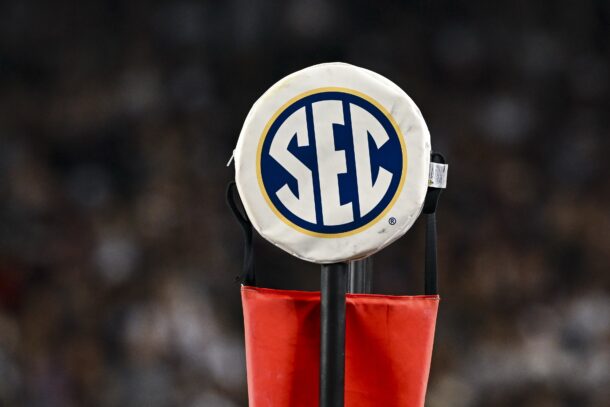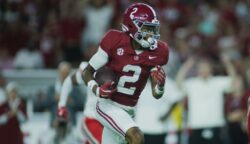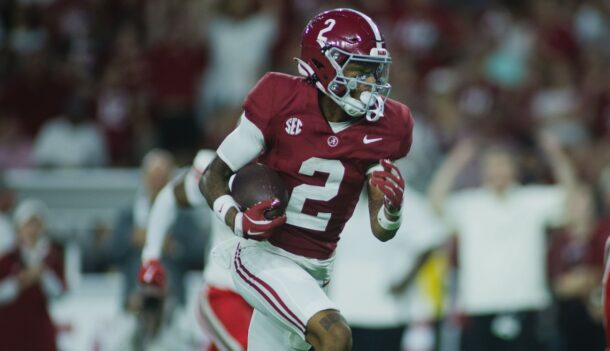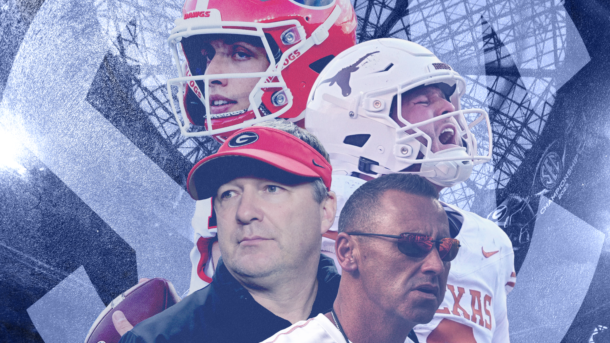
SDS’ Ultimate SEC Championship Preview: Georgia won Round 1 in a knockout. Does Texas have a counterpunch in Round 2?
By Matt Hinton
Published:
Everything you need to know about Saturday’s SEC Championship collision between Georgia and Texas, all in one place.
– – –
We, we made it. After 14 wild, unpredictable Saturdays and a month of poring over labyrinthine tiebreaker scenarios, we’re right where we thought we’d be back in August: Mulling over a rematch between Georgia and Texas, the top 2 teams in the preseason media poll and, when it was all said and done, the 2 most consistent teams in the SEC in this most inconsistent of seasons.
There were plenty of opportunities for the standings to break another way, but no one can claim they didn’t see UGA/TEX II: Bevo Strikes Back coming.
Of course, there’s much more at stake than the Longhorns avenging their only regular-season loss. True, unlike in past years, neither team is playing for its postseason life; both teams are presumably safely in the 12-team Playoff field that will be announced Sunday. But they are playing for seeding, and more specifically for the coveted first-round bye that goes with claiming the conference crown.
In Georgia’s case, the Dawgs are also playing to avoid giving the CFP committee any excuse to send them on the road in the first round to some frozen Big Ten outpost. And Texas, yes, would love to prove that its midseason flop against the Dawgs in Austin was a fluke. As it stands, that’s the ‘Horns’ only game against a currently ranked opponent, and Saturday is their last chance to put any lingering doubts about how they stack up to Playoff-caliber competition to bed before it gets real.
And last but not least: They’re playing to win their conference, full stop. In college football, that will always count for something, regardless of what other opportunities come with it. They’ve battled 14 other teams for 14 weeks for the chance to be the last one standing at the top of this particular hill, and 4 hours on Saturday the right to plant that flag for the 2024 season is high enough stakes in its own right.
Texas is a 3-point favorite, according to DraftKings Sportsbook. Outcome, TBD. Whatever we comes next, one of these teams will leave Atlanta a champion for the rest of their lives.
When Texas Has the Ball …
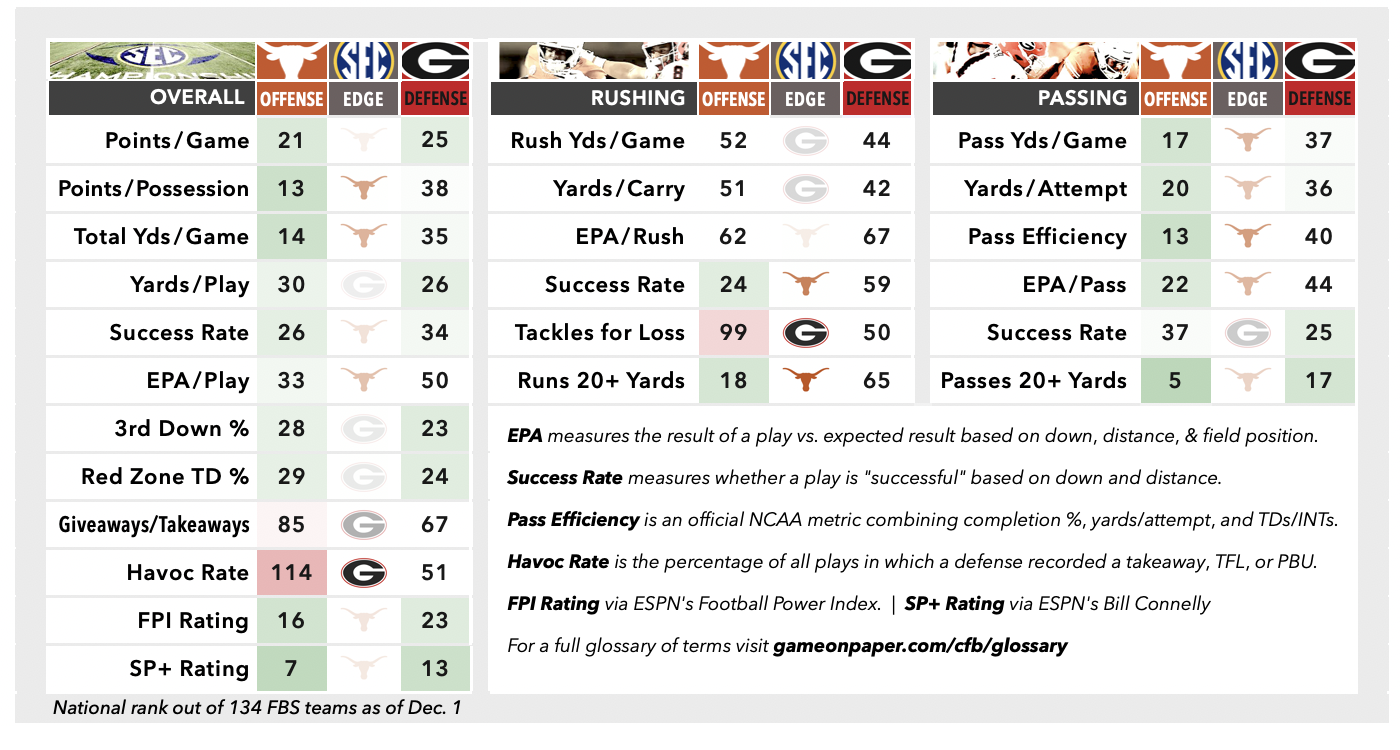
The stat: 1.89 points
That’s the average number of points per possession allowed by Georgia’s defense this season, per efficiency guru Brian Fremeau, 38th nationally and the largest number to date under Kirby Smart:
Georgia Points Per Drive Allowed (FBS Rank)
• 2016: 1.78 (31st)
• 2017: 1.19 (4th)
• 2018: 1.79 (34th)
• 2019: 1.06 (3rd)
• 2020: 1.71 (28th)
• 2021: 0.69 (1st)
• 2022: 1.29 (5th)
• 2023: 1.53 (13th)
• 2024: 1.89 (38th)
Not that anyone was mistaking the current defense for the heyday of Nakobe Dean and Jalen Carter prior to last week’s dramatic, 44-42 marathon against Georgia Tech, but giving up 563 yards in the course of going to 8 overtimes against an ACC also-ran has a way of emphasizing the point. Another way to put it into perspective: The escape against the Yellow Jackets marked the 4th time this season Georgia has allowed 28+ points and 6.0+ yards per play. Over the previous 3 years, the 2021-23 Dawgs didn’t allow 28 points or 6.0 yards per play in a single regular-season game.
The big question: Can Texas rum for a living?
On the handful of occasions that Georgia’s defense has hit its marks, it still manages a fine impression of a vintage Smart unit, never more so than in the Bulldogs’ 30-15 romp over Texas in Week 8. Besides serving as a humbling introduction to the SEC, that loss represented a major outlier for Texas’ offense in every way that matters, resulting in the Longhorns’ fewest points, yards and yards per play over the past 2 seasons, as well as the worst passer rating for QB Quinn Ewers. But it started up front, where the usually solid o-line was overrun, allowing 7 sacks and (excluding sacks) a season-low 88 yards rushing after the offense was forced into comeback mode in the second half. Pro Football Focus credited Texas running backs with a single missed tackle forced.
Heading into the rematch, all signs are that the ‘Horns have recommitted to establishing the run. The play selection skewed toward the running game in November, with the offense keeping it on the ground on nearly 60% of its total snaps and eclipsing 200 rushing yards in 3 of the last 4 games. (In the first 8 games, Texas hit the 200-yard rushing mark just once.)
In part, that was due to playing with the lead against a series of opponents — Florida, Arkansas, Kentucky and Texas A&M — whose offenses posed little threat of closing the gap on their own as long as Texas’ offense didn’t gift-wrap points via turnovers. (In fact, Kentucky and A&M both scored defensive touchdowns off Longhorns turnovers, while their offenses managed just 1 TD between them.) It was also due to the emergence of sophomore RB Quintrevion Wisner from a rotational role into an every-down grinder.
Wisner was a bona fide workhorse over the past 2 games, racking up 26 carries against Kentucky and 33 against A&M for a combined 344 yards, the majority of it in both games coming after halftime as Texas methodically snuffed out the clock. Per PFF, a little more than 70% of that total also came after contact, as a result of a combined 17 missed tackles forced across both games. Against the Wildcats, Wisner logged 11 carries on a single possession, a 15-play, 86-yard touchdown drive that spanned more than half the 4th quarter, featured zero passes, and slammed the door shut on any possibility of a Kentucky comeback.
Meanwhile, the dominant midseason turn in Austin is turning out to be an outlier for Georgia’s defense, too. Lately, the Dawgs are in the midst of what (by Georgia standards) might be the most alarming stretch of run defense since the early days of Smart’s tenure: They’ve allowed 200+ rushing yards in consecutive games, the first time that’s happened since the end of Smart’s first season as head coach in 2016, and an individual 100-yard rusher in each of the last 3. Georgia Tech ran for 260 in Week 14, the highest single-game rushing total for an opposing offense in more than 8 years.
Notably, the Yellow Jackets’ leading rusher was their quarterback, Haynes King, whose nose-for-the-sticks running style yielded 110 yards on 24 carries and allowed Tech to rack up a 14-minute advantage in time of possession — nearly a full quarter’s worth of game time that Georgia’s more explosive offense was not on the field. That came just a few weeks after Ole Miss’ Jaxson Dart ran for 55 yards in the Rebels’ decisive Week 11 win over Georgia in Oxford.
Quinn Ewers is no threat in that department, especially on a gimpy ankle that limited his already-limited mobility against Texas A&M. But expanding the QB run game presents a welcome opportunity for Arch Manning, who got a handful of snaps in College Station in a Wildcat role in the red zone. Manning’s athletic, 15-yard touchdown run against the Aggies was his 4th of the year, with 2 of the other 3 covering 67 yards (against UTSA) and 26 yards (against Mississippi State), respectively. Steve Sarkisian has adamantly refused to entertain the notion that Ewers’ status as QB1 is at risk since his return from a brief injury absence in September, and Ewers hasn’t done anything to lose it. But if shoehorning Manning into his own version of a Baby Tebow package is what it takes to get him meaningful reps, it’s worth it.
Key matchup: Texas OT Cameron Williams vs. Georgia LB/Edge Jalon Walker
Walker was unblockable in Georgia’s midseason win in Austin, accounting for 7 QB pressures and 3 of the team’s 7 sacks in a money-making performance. He’s been relatively quiet since, recording just 6 pressures and 1 sack over the past 5 games. Unlike in the past, this defensive front is not overstocked with next-level dudes: The Dawgs need their best athlete to be a difference-maker.
On the other side, Williams got the worst of it in the first meeting, giving up a sack and a pair of QB hits while getting flagged twice. Per PFF, his 13 penalties for the season are tied for the most of any SEC offensive lineman. Texas’ other starting tackle, aspiring first-rounder Kelvin Banks Jr., is listed as questionable due to an ankle injury; his backup, redshirt freshman Trevor Goosby, just saw the first meaningful action of his career last week after Banks went down at Texas A&M. Whoever winds up opposite and Walker and fellow bookend Mykel Williams, the Longhorns desperately need them to keep their powder dry.
When Georgia Has the Ball …
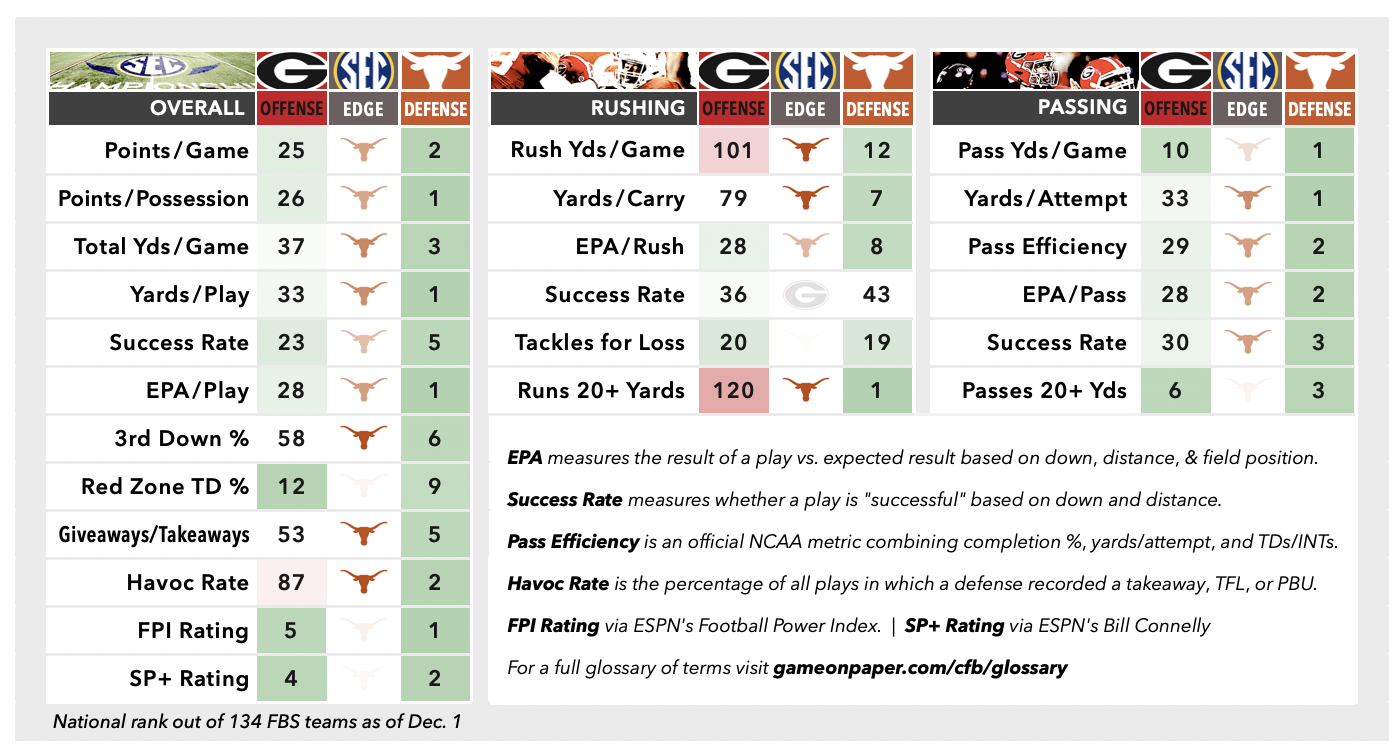
The stat: +14
That’s the difference between interceptions (18) and touchdown passes allowed (4) by Texas’ defense this season, easily the widest margin in the country in 2024 and one of the widest of the past decade. Only 1 FBS defense since 2016 has posted a bigger INT/TD margin: Illinois in 2022, which picked off 24 passes vs. 9 touchdowns allowed to finish +15. No other team in that span has finished better than +11.
That’s just one of the many ways Texas comes in at or near the top of the national rankings against the pass, the Longhorns’ most consistent strength over the course of the season. Depending on your biases, you can chalk that up to either a) The home-grown talent on hand in a secondary that features just 1 transfer among the regular rotation (senior safety Andrew Mukuba, a big-ticket addition from Clemson); or b) A truly grim array of opposing quarterbacks. Outside of Georgia’s Carson Beck, the ‘Horns haven’t faced a top-40 offense or a quarterback who projects to the next level. In fact, most of the opposing QBs they’ve encountered in Power 4 play have been freshmen, walk-ons, backups, or some combination thereof still in the “mewling babe” phase of their careers:
• Michigan: Davis Warren (former walk-on, 2nd start)
• Mississippi State: Michael Van Buren Jr. (true freshman, 1st start)
• Oklahoma: Michael Hawkins Jr. (true freshman, 2nd start, later benched)
• Florida: Aidan Warner (redshirt freshman, former walk-on, 1st and probably last start)
• Kentucky: Cutter Boley (true freshman, first extended FBS action off the bench)
Warren is the only name on that list who began the season as his team’s starter, and in his case that was a late-breaking development that threw everyone for a loop. (Warren subsequently went on to spend more than a month on the bench before his number came up again for the home stretch; he led Michigan’s dramatic, 13-10 upset of Ohio State while throwing for 62 yards and 2 INTs on 9-of-16 passing in what will certainly be his last game as the Wolverines’ starter.) Throw in Texas A&M’s Marcel Reed, a redshirt freshman who didn’t take over full-time until November, and you’ve got yourself a lineup ripe for the picking, literally. Altogether that group threw 6 interceptions against the Longhorns and didn’t lead a touchdown drive in the competitive portion of the proceedings.
On the other hand, it has to be said that the veteran exceptions to that trend — Beck, Vanderbilt’s Diego Pavia and Arkansas’ Taylen Green — didn’t fare all that much better than the fledglings. For his part, Beck threw 3 INTs (and no TDs) against Texas, setting career lows for yards per attempt (4.3) and overall efficiency (77.3) in the process. Pavia and Green combined to throw 3 picks while averaging a pedestrian 5.4 ypa. Pavia did account for 2 of the 4 TD passes Texas has allowed this year, 1 of them an insane 4th-down heave that sailed just past the fingertips of 3 different Longhorns defenders, in what probably qualifies as the best performance by an opposing QB all year.
Each week that he retains the title in the postseason is another week the ‘Horns should easily advance.
The big question: Is Carson Beck’s midseason interceptions spree out of his system?
From Weeks 5-11, Beck served up a dozen picks in 6 games. In addition to his 3-INT outing in Austin, he threw 3 rapid-fire picks against Florida, giving the Gators life in a game that had no business being close, and closed out the losses to Alabama and Ole Miss with game-clinching interceptions in both games. For a while there it looked like a crisis that put Georgia’s season and Beck’s mercurial draft stock at risk.
Lately, though, he’s back to looking like his old, placid self. He’s attempted 118 consecutive passes without a pick, 23 of them covering 20+ air yards and 11 going for touchdowns.
He turned in the best performance of his career in a gotta-have-it win over Tennessee; threw 4 TDs in a prolific outing against UMass; and pulled off the comeback against Georgia Tech by leading 4 consecutive touchdown drives to close out regulation. His crunch-time performance against the Yellow Jackets was the main reason Georgia was even in a position to take that game to extra frames despite big deficits in total offense and time of possession. In the 4th quarter and first 2 rounds of overtime (excluding the alternating 2-point plays beginning in the 3rd OT), Beck was 17-for-20 for 169 yards and 4 TDs, with the game and the season on the line every time the ball left his hand.
For now, anyway, his name has been again placed atop the list of the team’s concerns by the defense.
That can change quickly, especially if Texas succeeds in turning up the temperature. For the season, Beck has been among the best-protected quarterbacks in the country, facing pressure on an SEC-low 20.6% of his total drop-backs, per PFF. But certain opposing fronts have made their presence felt more than others — Ole Miss, hello — and the results under duress have been ugly. Beck’s 35.6 PFF grade on pressured drop-backs ranks near the bottom of the conference, and his rate of “turnover-worthy plays” on those reps (9.2%) is dead last.
An unstable, injury-plagued line hasn’t helped. Eight o-linemen have started multiple games for Georgia in 4 different configurations. At the same time, Texas’ defensive line has emerged as a force, reflecting both the investment the Longhorns have made in upgrading the talent level and the development of a handful of late-blooming seniors. On the former front, 5-star underclassmen Anthony Hill Jr. and Colin Simmons are already well on their way to paying off the recruiting hype, and transfer Trey Moore has been a productive (if unsung) addition from UTSA; on the latter, vets Barryn Sorrell, Alfred Collins and Vernon Broughton have all leveled up in their final year on campus. Any or all of the above are capable of wreaking havoc, and they collectively made their presence felt in the first meeting, generating 14 QB pressures despite failing to record a sack. This time, the mission must be putting Beck on his back early and often.
The key matchup: Georgia WR Arian Smith vs. Texas CB Jahdae Barron
Georgia fans weren’t quite sure what to expect from Smith in his final year on campus, and as we approach year’s end, well, they still aren’t. The good news: After 4 injury-plagued seasons in “heir apparent” mode, Smith has played in every game, accounting for a team-high 750 scrimmage yards on 16.3 yards per touch. The not-so-good news: He’s been wildly inconsistent, disappearing for entire games at a time and earning as much attention for his unreliable hands — PFF has him down for 9 drops on 42 targets, most in the SEC — as for his explosiveness. His 4 touchdown receptions averaged 34.5 yards a pop, 3 of them coming in games in which he eclipsed 100+ receiving yards; he also had 4 games in which his yards-per-catch average languished in the single digits.
One of the games in the second column was the first meeting against Texas, where Smith finished with 6 catches (OK) on 7 targets (okaaay) … for 32 yards (woof). For much of the night he was lined up opposite Barron, including the infamous play in the 3rd quarter that inspired Texas fans to hurl debris onto the field in protest after a flag for defensive pass interference negated an apparent Barron interception. Yada yada yada, the pick ultimately stood, giving Barron his 2nd INT of the game and his 3rd of 4 on the year. Altogether, he’s faced 49 targets this season without giving up a touchdown, per PFF, the most of any SEC defender without allowing a TD at his expense. As maddening as he can be, there are still few players in the conference capable of ruining that distinction as quickly as Smith.
Special teams, injuries and other vagaries
Georgia sophomore Peyton Woodring is one of the most bankable kickers in the college game: He’s a perfect 14-for-14 on field-goal attempts from inside of 50 yards and a solid 3-for-5 from long range. Woodring’s last attempt, on a 53-yard try at the end of the first half against Georgia Tech, snapped a streak of 8 straight connections since midseason. Meanwhile, his Texas counterpart, senior Bert Auburn, is fending off a slump. In his first 2 seasons as the Longhorns’ primary kicker, Auburn was a prolific 50-for-61 on field goals (82%), including an FBS-best 29 successful kicks in 2023; this year, he’s just 10-for-15 with 3 misses in the past 4 games. He’s never been a reliable threat from distance, with only 1 attempt of 50+ yards this year (a miss vs. Florida). If it comes down to a kick, at the moment the Dawgs trust their guy a little bit more.
There’s not much to see in the return game, although make a note that the primary punt returners, Texas’ Silas Bolden and Georgia’s Anthony Evans III, both have multiple muffs on their ledger this season. For what it’s worth, Georgia’s Brett Thorson is PFF’s top-graded punter nationally — yes, punters get grades, too — averaging an FBS-best 4.53 seconds of hang time and an SEC-best 44.2 net yards per attempt. He’s a Ray Guy Award finalist and the rare non-Australian punter these days with an actual shot at getting drafted.
Injury-wise, both sides arrive relatively intact for this time of year, with the notable exceptions of Texas OL Kelvin Banks Jr. (ankle) and Georgia RB Trevor Etienne (ribs), both listed as “questionable” on the initial weekly injury report. Reading the tea leaves, Steve Sarkisian sounded more optimistic early in the week about Banks’ availability (“it was a good start to the week for him”) than Kirby Smart did about Etienne’s (“Trevor’s a ways away … He wasn’t really close to playing last week”).
Looking further down the depth chart, there’s a slim chance that the Dawgs could get contributions in Etienne’s absence from either Branson Robinson, who has been upgraded to questionable after nearly 2 months on the shelf due to a knee injury, or Roderick Robinson II, who made his first appearance of the season last week following an extended battle with turf toe. But Texas will take that trade in a heartbeat.
A uniform note: Although Texas is the designated home team, the Longhorns have reportedly opted to wear their road whites, perhaps as a subconscious nod to the fact that they read as the visitors in Atlanta in more ways than one. Besides their newbie status in the conference, Saturday is Texas’ first trip to Mercedes-Benz Stadium, a building Georgia knows like the back of its hand. (Texas has played in Atlanta just once before in school history: In the 1957 opener against Georgia, played in what was then known as Grant Field; today, it’s Bobby Dodd Stadium, home to Georgia Tech.) After Saturday, there are still 2 more games slated for Mercedes-Benz Stadium in the Playoff: The Peach Bowl on Jan. 1 and the CFP Championship Game on Jan. 20. Maybe if they find themselves in either of those games the ‘Horns will feel more at home.
Bottom line
The stage and the stakes are familiar, but this is a very different Georgia team than the ones that sauntered into Atlanta the past 3 years. From 2021-23, the Dawgs were 36-0 in the regular season and rarely challenged along the way, arriving at this point on the calendar as the undisputed No. 1 team in the country all 3 seasons. Once you get past the residual respect for the brand, the 2024 edition is still in search of a coherent identity.
It’s always tempting to write something that starts along the lines of “when the Dawgs look like themselves,” but at this stage of the season, who are they? What are they really good at? On paper they’ve regressed significantly at everything. They have managed a couple of complete performances worthy of the championship years, against Clemson early and Tennessee late. At every other point along the way, they’ve left serious question marks even in the wins.
The offense averaged a stinker per month, struggling against Kentucky (September), Texas (October), and Ole Miss (November). Turnovers, drops and o-line play have all been issues. The defense has struggled at various points against the run and the pass, and on a couple of memorable occasions against both. The margins have shrunk. The ’21-23 teams trailed in the 4th quarter exactly once en route to 36-0 — in a 2022 win at Missouri; the ’24 team has been forced to stage comebacks against Kentucky, Florida and Georgia Tech, not to mention the doomed rally against Alabama.
Of course, it’s to their credit that even an off-brand version of the Georgia juggernaut is still here, extending its championship window by any means necessary. Despite the lows, the glimpses we have of the Dawgs at their best can still inspire visions of confetti falling in January. They’re potentially explosive, potentially sweltering on defense, potentially capable of putting it all together on any given Saturday. But if they’re actually capable of stacking 4 confetti-worthy performances in a row, the time has come to prove it.
If anything, Texas looks more like a stereotypical Georgia outfit than Georgia does: Strong in the trenches, steady from one week to the next, content to allow a balanced-but-boring offense to play it safe opposite a killer defense. Texas’ D under 4th-year coordinator Pete Kwiatkowski has been the most reliably dominant unit in college football this season, to nearly the same extent that UGA’s defense was in its championship runs in 2021-22. The Longhorns haven’t had a red-flag game on that side of the ball and boast NFL talent at all three levels.
The caveat, again, is the competition. The Longhorns still have to prove that the blueprint holds up against a Playoff-caliber opponent. If the defense is up to holding the Dawgs in check again, it’s the offense’s turn to prove it’s good enough to make up the difference.
– – –
• Texas 23 | Georgia 19
Scoreboard
Week 14 record: 9-1 straight-up | 7-3 vs. spread
Season record: 103-25 straight-up | 77-48 vs. spread
Matt Hinton, author of 'Monday Down South' and our resident QB guru, has previously written for Dr. Saturday, CBS and Grantland.
